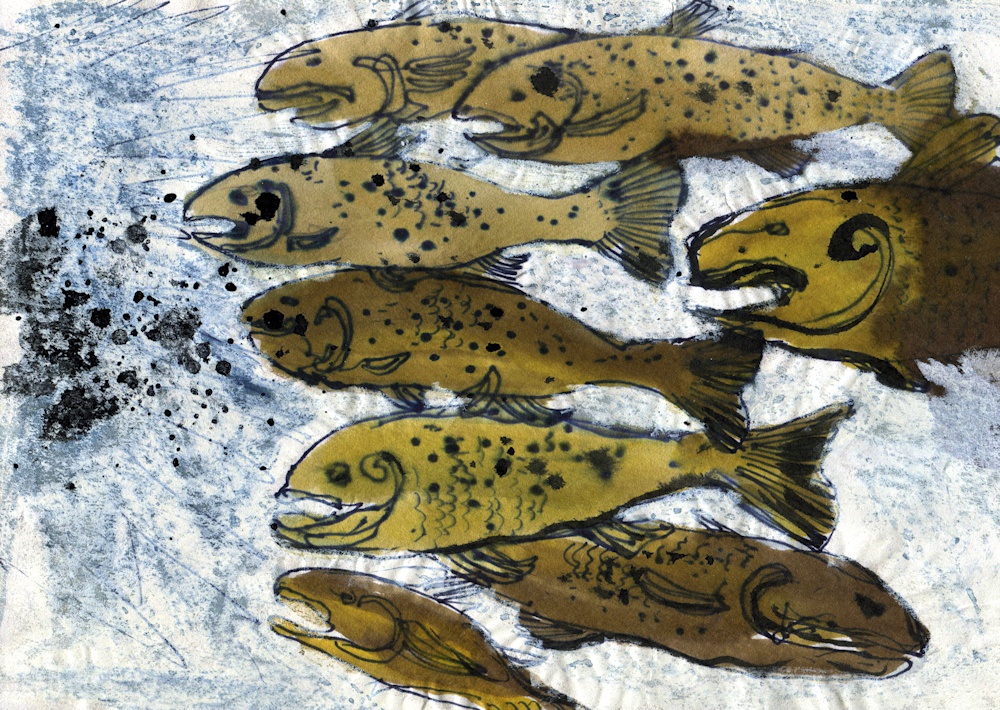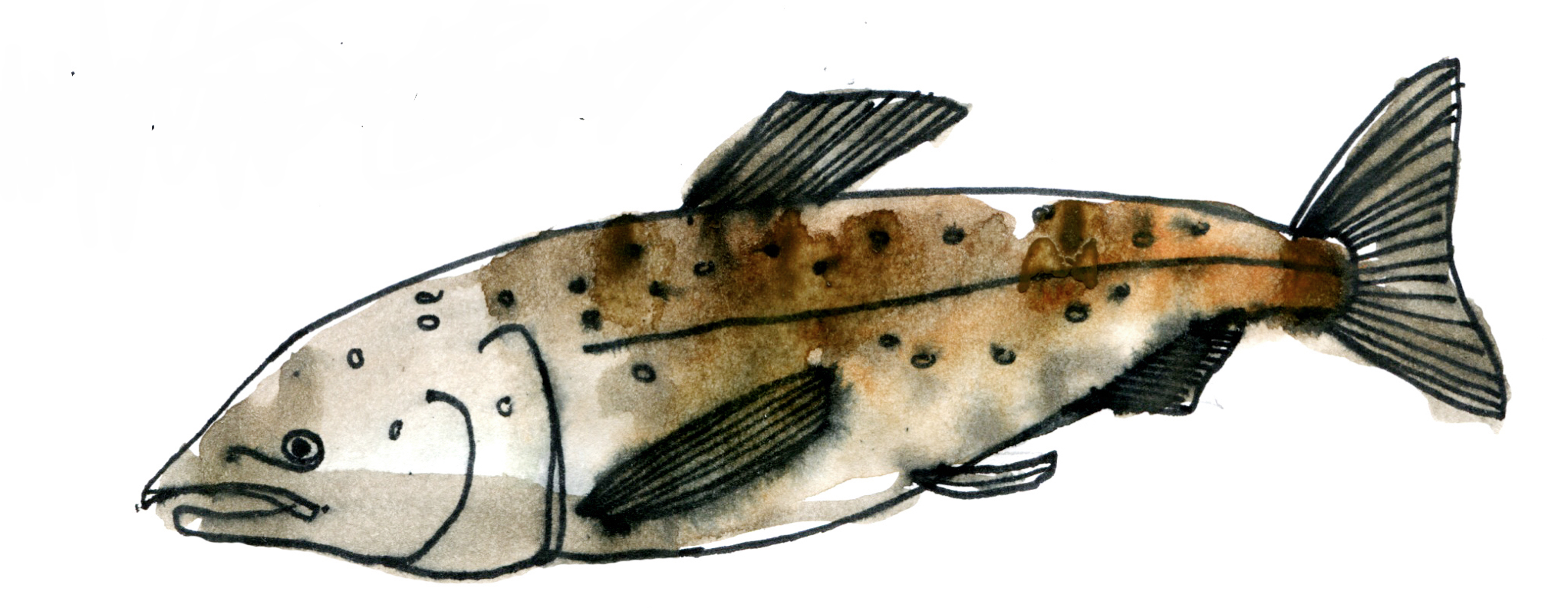
Drawings: Kasia Jackowska
Salmo salar, Atlantic salmon
Origin and life style
The Atlantic salmon belongs to the class of the ray-finned fishes, to the order of Salmoniformes and to the family of Salmonids. Wild Atlantic salmon live off the coasts of the Northern Atlantic ocean, along the USA and Canada and from Portugal to Scandinavia and up to Southern Greenland and Iceland, as well as in more than 2000 bordering rivers. They have been introduced to the Bering Sea. They can reach a maximum age of 13 years, a maximum weight of 47 kg and a maximum length of 150 cm (male) or 120 cm (female). The common length is 38 cm. It seems that growth increases with decreasing population density, but more studies are needed to be sure.
Atlantic salmon spawn in the upper course of rivers between October and January. In the first summer of their lifes, fry develop into “parr” and live in their river of origin for at least 1 and up to 5 years, extending their home range up- or downstream from less than 100 metres to several kilometres as they grow. Finally they adapt to seawater in spring, transmuting into “smolt". Subsequently they migrate to the sea where they live as adults for up to 4 years. After all, they wander back upstream in winter as “grilse" to their birthplace for spawning. Exhausted by this journey, most adults die; only a few called “kelt” make it a second time.
It is still speculative how Atlantic salmon manage to home exactly to their place of birth. It could be by an interaction of sensing the magnetic field and an imprint of the scent of the water in either the olfactory system or the lateral line or both.
Atlantic salmon establish dominance hierarchies already at the fry stage. Dominant individuals are highly active in places with food abundance and show aggressiveness towards subordinates, the latter swimming upwards, hardly moving and staying away from food. In the wild, parr are territorial and occupy habitat with high drift rates and low densities. Older parr tend to stay farther from the shore and from the bottom in order to enhance food availability. Younger parr on the other hand have to be satisfied with suboptimal feeding grounds where in return predator risk is reduced. It seems that increasing density increases the frequency or severity of aggression, but other factors may play a role, too.
In rivers, smolt swim passively downstream most of the time, head first. This is also their escape movement if there is no other way out. In streams, adults reach a net ground speed of 0.2 to 28 km per day whereas in the sea they move about 15 to 30 km per day. To keep buoyancy, Atlantic salmon swallow air during jumping over the water surface.
In the wild, the individually required patrol space increases with age. Juveniles seam to swim <0.1 km (up- or downstream), older parr several km, smolt up to 1800 km to the sea, depending on habitat and barriers. The preferred depth ranges from 10 to 60 cm, but if the habitat allows for, Atlantic salmon swim as deep as 6.5 m or even deeper. Under farm conditions, adults were observed to use the full depth available, down to 15 m. Individuals dive deep to withdraw from abrupt light changes, intensive light, sounds, or predators. In order to dive, Atlantic salmon deflate their swim bladder and re-fill it afterwards.
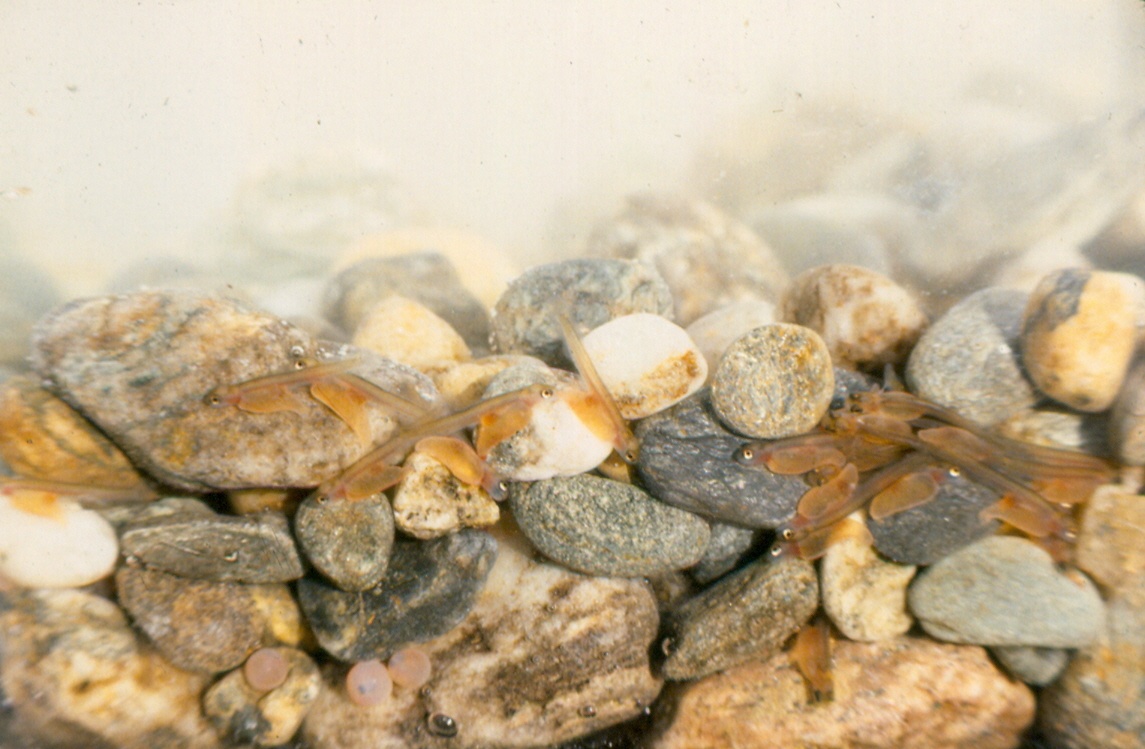
Atlantic salmon juveniles remain in the gravel habitat of their redd (nest) until their yolk sac is depleted. (Photo: E. Peter Steenstra, U. S. Fish and Wildlife Service, Wikimedia)
Preferences for various substrates, water velocities, water temperatures and patrol space differ remarkably. Generally, Atlantic salmon are opportunistic in substrate choice, but avoid fine material like sand and mud. Most parr prefer larger stones as shelter but make use also of aquatic plants, overhanging vegetation or deadwood. Parr shelter individually and do not share a shelter they found.
Atlantic salmon typically live in water temperatures between 0 and 20 °C with preferences between 4 and 18 °C, a swimming optimum at 16-17 °C and a growth optimum at 14-19 °C. They reduce or stop feeding below 6-7 °C or switch to nocturnal feeding. They potentially survive lower (rivers with ice cover) or higher temperatures if they can divert to water levels with different temperatures or have shelter. The main problem of ice cover in rivers is that it decreases the winter habitat area and that it reduces the spawning season.
Juveniles avoid habitats with an average column velocity below 3 cm per second whereas they prefer velocities above 6 cm per second. With decreasing water temperatures, Atlantic salmon try to avoid higher flow velocities in riffles and runs.
Atlantic salmon are predominantly carnivorous, feeding on invertebrates, mainly on aquatic insects. The prey of the different life stages overlaps generally, but younger Atlantic salmon feed rather on smaller, older rather on larger species. In the wild, parr feed as well on benthic as on drift prey.
Atlantic salmon are diurnal. Foraging by sight, they are less active and less territorial in the dark and tend to rest at night. Juveniles and adults move deeper in the water column during day than during night, probably to avoid intensive daylight. Nocturnal activity is occasionally observed at low temperatures. Smolt however migrate at night, probably to avoid predators.
Atlantic salmon are sensitive to blue-green light. In cages, they dive away to the bottom to escape blue light of low intensity at night whereas they swim furiously at higher light intensity. Infrasound or slapping on the water surface leads to increased swimming and diving.
For spawning, temperatures must be above 10 °C for 3 months and should not exceed 20 °C except for a few weeks. Females avoid fine substrate and prefer grain size of up to 10% of body size. The female cuts one redd on average by repeated flexures of her body. She deposits up to 450 eggs 15-25 cm deep in the gravel to protect them from light, predators and high flow rate. The dominant male chases rivals away from the spawning site.
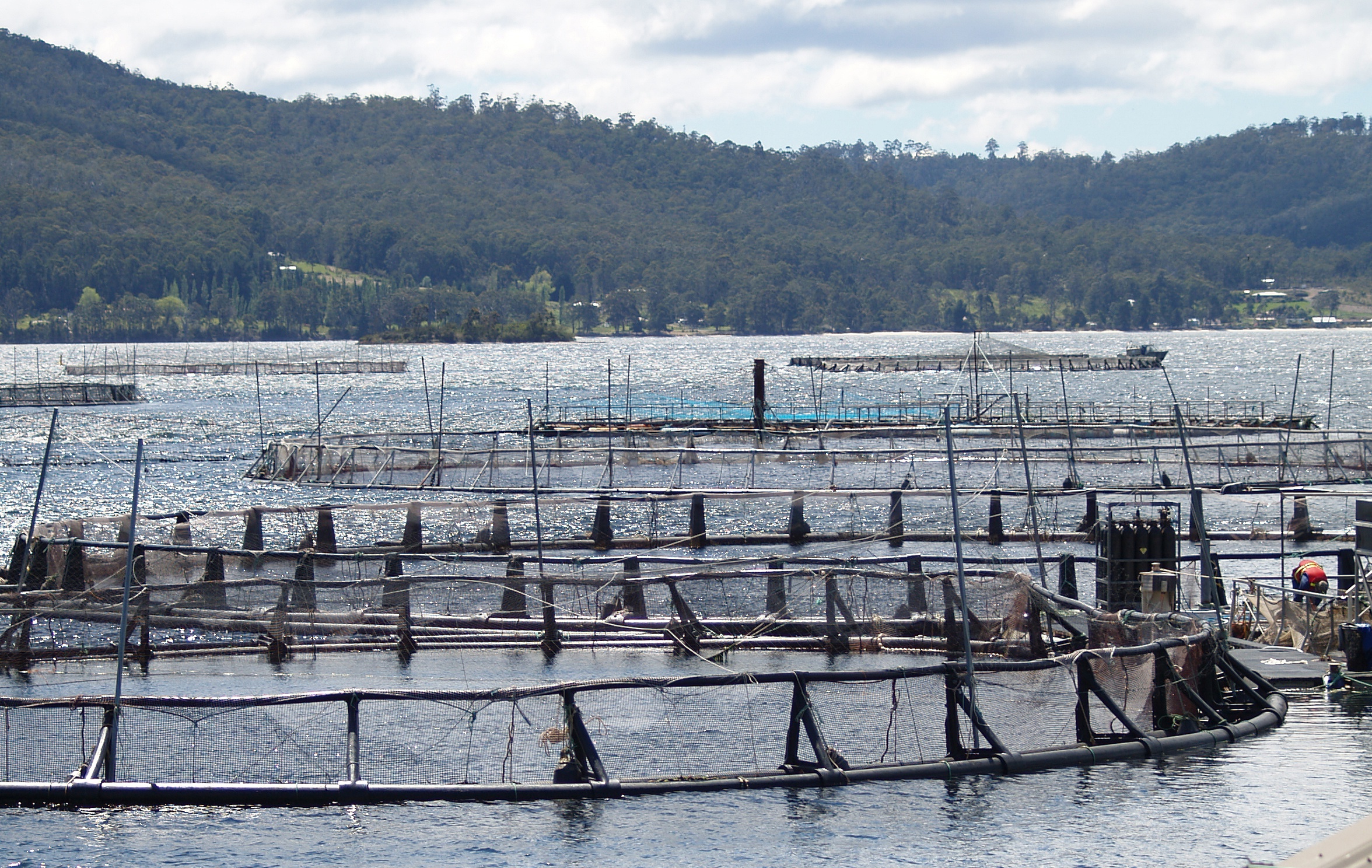
Fattening of Atlantic salmons in net cages in the sea (photo: Peter Whyte, CSIRO, Wikimedia)
The development of salmon farming
The history of Atlantic salmon culture is a rather short one. It began in the 19th century in the United Kingdom by restocking waters with parr to enhance returns for anglers. Farming of Atlantic salmon with the aim to supply the consumer market started in the 1960s only, with net cages in Norwegian fjords and, after first successes, in Scotland, Ireland, France, Spain and the Northeastern parts of Canada and the USA. After 1980, Atlantic salmon farming reached even regions where the species had never lived before, like Chile and Australia.
The farmed Atlantic salmon of today is a hybrid of various strains. The increase in number of farms, in the level of industrialisation and in volumes of production has led to falling prices and to cost pressure and consequently to further intensification. Severe outbreaks of salmon diseases questioned the production in Norway in the 1980s and in Chile in the late 2000s.
Farmed Atlantic salmon are reared in freshwater nurseries. They smoltify in the first or second year of life, depending on the temperature and light regime on the breeding farm. For fattening, most smolt are transferred to net cages anchored offshore. Cages can measure up to 24 square metres surface area, in rectangular or circular design, and may reach depths of 15-18 metres. Alternatively some smolt are fatted in tanks at coastal sites, with seawater pumped ashore.
The most recent and sophisticated farms however use the recirculation technique (RAS) in inland-based closed containment systems. Plants for smolt production and also for growout have been established already in the USA, Canada, Scandinavia and China; RAS with Atlantic salmon are projected in the Swiss Alps and in Abu Dhabi. RAS salmon farming is experiencing a questionable twist through a project with faster and bigger growing transgenic Atlantic salmon that is still waiting for approval by US authorities for years already. The project initiators argue that thanks to RAS, none of their transgenic fishes will ever escape into the wild. Usually, however, RAS salmon farming has nothing to do with genetically modified fish.
Growing constantly, aquaculture currently provides more than 2 million tons of Atlantic salmon (2012) whereas the volume of wild caught conspecifics has become practically irrelevant.
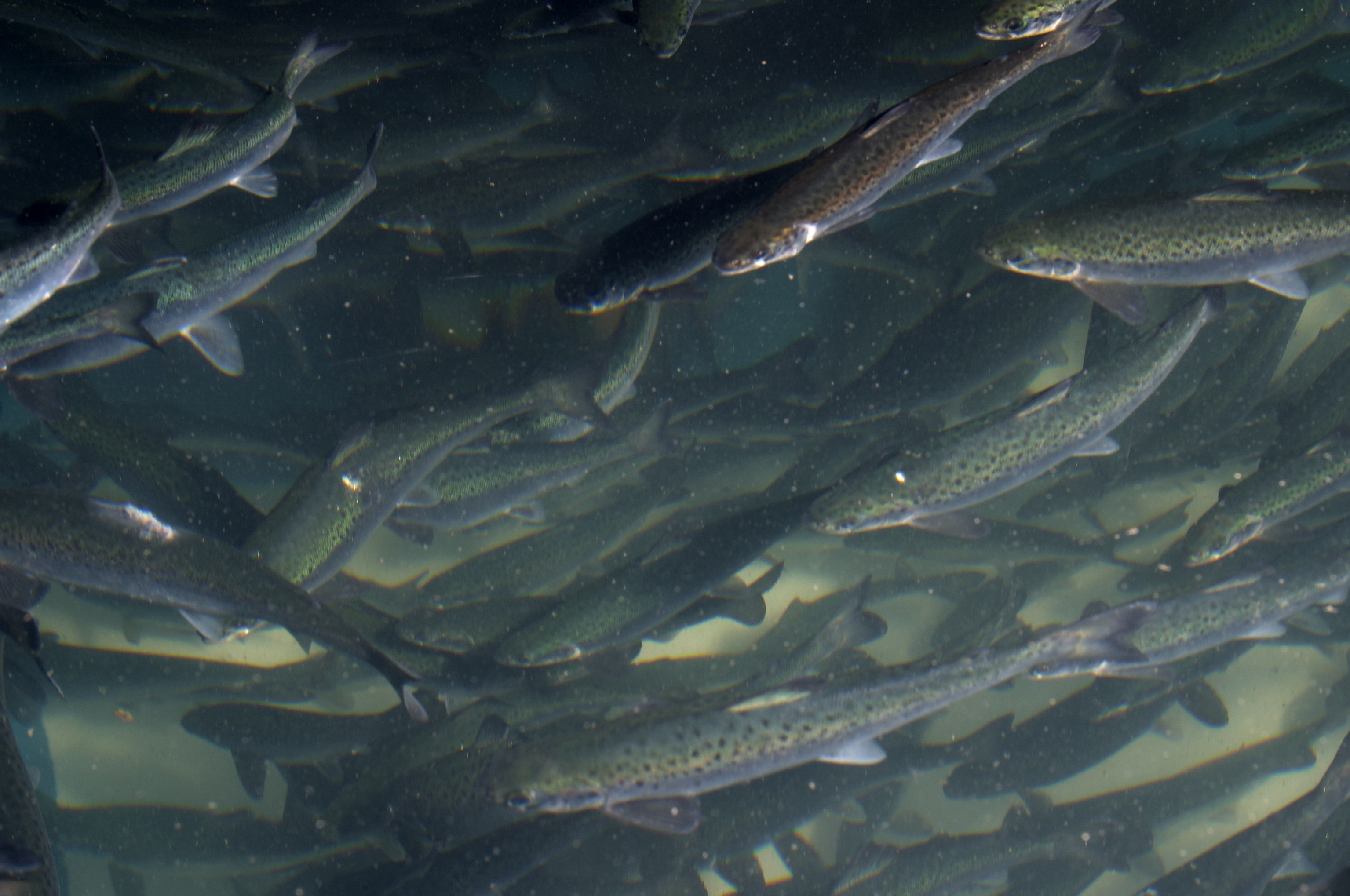
Atlantic salmons in a tank (Photo: Peter Whyte, CSIRO, Wikimedia)
Major problems of common salmon farming
A major problem of Atlantic salmon farming in cages is the risk of escapes. Among the possible influences on native conspecifics is additional competition for food and habitat and – maybe even more important – infection with diseases and mating with natives. Because hatchery-reared Atlantic salmon have a narrower gene pool, the resulting hybrids could lack fitness which can ultimately threaten the survival of native Atlantic salmon. This is one of the major fish welfare problems of salmon farming because it impairs fishes in the wild.
Although some may question whether hatchery-reared Atlantic salmon are capable of surviving in the wild long enough to do harm, there is no reason to assume otherwise. Atlantic salmon have only been farmed for 150 years – even species that have been domesticated for thousands of generations, like hens or pigs, display the full repertoire of their archetype's behaviour if they are allowed to.
As there is no pen cage that prevents absolutely every escape, the only 100 percent secure farming systems are RAS in closed containment, because they exclude escapes.
The most important welfare problem of salmon farming however is the confinement of a species that needs a home range much broader than any farming system could ever offer. In the wild, smolt travel several kilometres downstream to the sea and there, move up to 30 kilometres a day. In the farming system, they do not have to migrate as they are carried to the sea, and they do not have to roam as the feed is provided to them. The crucial question however is: Do Atlantic salmon consequently lose the urge to wander?
As there is no sound evidence for answering this question affirmatively, we should still consider these fishes as wanderers. But what does this mean? Do Atlantic salmon feel like wandering when steadily swimming against a sea current in the cage or against the inlet current in the RAS basin? When we recall the fact that Atlantic salmon are able to find their way back to their birth site over hundreds of kilometres, it does not seem very plausible that swimming in always the same place should be a species-appropriate way of wandering.
In the future, a sophisticated system could perhaps simulate geographical field-markers in order to satisfy the urge to wander, and RAS would of course be the most suitable to implement it in. For the time being there is simply no solid answer to the wandering question. All one can do now is to look for an answer and to be prepared to introduce it in salmon farming.
A third major fish welfare problem is caused by the confinement in a narrow and uniform habitat, with several consequences: lack of possibilities to withdraw from dominant conspecifics, lack of stimuli and increased risk of outbreak of various diseases.
RAS can be managed so that they prevent diseases, and their sophisticated technology could even be designed to offer withdrawal opportunities and various stimuli. On the other hand, especially RAS tend to increase the population density to cope with the economic constraints driven by high initial investments and operation costs.
Despite fierce debates between farmers and protectionists, density in our judgement does not constitute a fish welfare problem in itself, at least as long as it is kept within certain limits drawn by water parameters. Density will become an issue however when raised to a point where no place is left for structures in the habitat which new research may advise to include. This is especially true for RAS that were designed on the basis of too optimistic business plans and consequently increase the production volume and thus density to not disappoint the investors.
A last major fish welfare problem has to do with the feeding of Atlantic salmon who by their nature feed on fish. Farmers will have to decide whether or not to rear a carnivorous species that is fed wild fish. This does not affect the target species alone but impairs the marine food chain and consequently the living of marine animals, thus animal welfare. Not to mention the welfare of about 450-1000 milliard* fishes caught for feed annually. As more and more consumers become aware of these matters, aquaculture of omnivorous or herbivorous species could prove to be the better choice in the very near future.
* Milliard in FishEthoBase = a thousand millions
Labels are not helpful for clients who care for the welfare of farmed fish. The guidelines of organic labels are the ones most inclined to grant animal welfare, yet they define no tangible instruction. All other labels address animal health at best, but do not acknowledge all-encompassing aspects of animal welfare. That is to say that even fishes farmed under labels like organic, ASC, or Friend of the Sea, often live under the conditions of intensive animal husbandry.
If we want to change the disregard for animal welfare, we need more of two things: ethological research and pressure from concerned consumers who want to eat respectfully-farmed fish.
